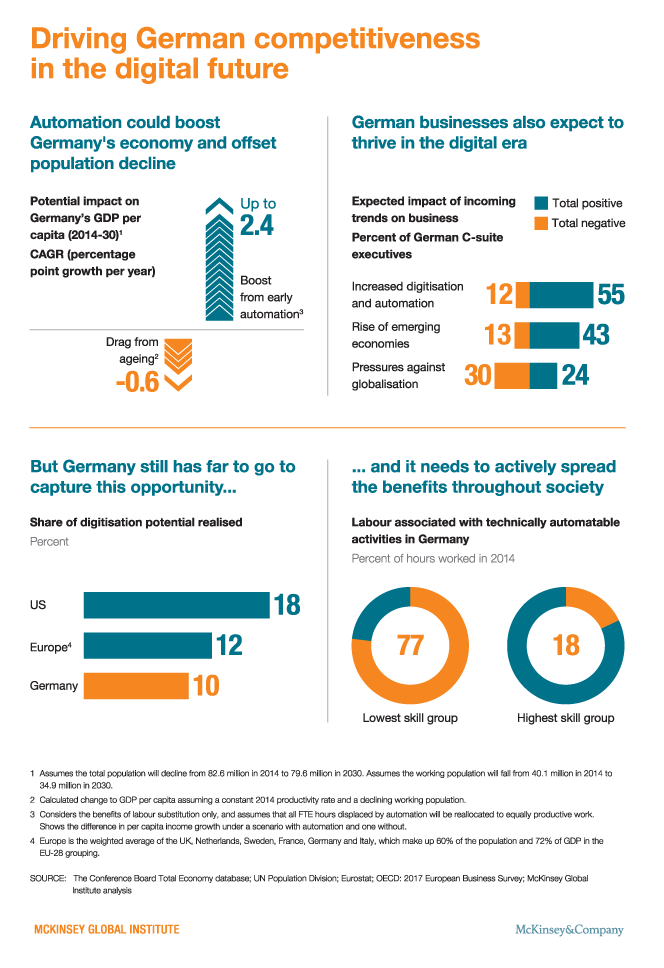By the end of 2016, new residential building permits issued in Germany resulted in more than a 20% increase compared to the previous year. More than 380,000 residential building permits were issued by the end of 2016, a huge increase from the 313,000 issued in 2015. According to Housing Minister Barabara Hendricks, this is the highest number of permits since 2000. She continued to suggest that a building boom will continue to support economic growth over the next few years.
The housing shortage in urban areas and low-interest rates have revitalised people to invest in homes instead of renting. This increase in property investment seems to solidify the forecast that the construction sector will continue with its solid performance. Industry experts are expecting construction sales to rise by 5% this year — this will be the highest level since 1995 following last year’s 5.8% growth.
Currently, construction is one of the major contributors to Germany’s economic growth — 0.3% points to an overall 1.9% GDP growth rate in 2016. This overall growth seems to be the strongest in the last 5 years.
Before the increase of refugees in 2015, urban areas were deficient of an estimated 800,000 affordable flats owing to higher immigration from other European countries. The obvious surge in demand more than exceeds the supply and soared property prices and rents especially in cities like Berlin, Munich, and Hamburg.
Around 280,000–290,000 homes were completed by the end of 2016 and expect up to 320,000 new homes this 2017. Forecasts suggest that at least 350,000 new homes are needed to be constructed efficiently each year until 2020 to cope with the shortage of affordable housing.
Potential Disruptive Trends Ahead
With Germany’s economy and employment growth (10% in over a decade) and an ageing population, Germany is in a condition to deal with possible disruptive trends. However, to maintain the economic position, the country needs to quickly adapt to speedy global changes in digitisation.
In a study released by McKinsey Global Institute entitled Driving German competitiveness in the digital future, the study estimated that a quick adoption of newer technologies, Germany could add up to an extra 2.4% of annual per-capita GDP growth by 2030. This would compensate for the 0.6% annual drag on per capita GDP growth from aging and will help the country sustain its historical per capita GDP growth rate.

The McKinsey index shows that Germany currently only captures 10% of the global digital potential, defined as the upper bounds of digitisation in the most digitised economy, which is 18% in the United States. Aside from falling behind the United States and China in terms of full-scale adoption, Germany does not have large-scale consumer tech companies and online platforms to challenge global tech giants like Apple and Alibaba. Basically, Germany operates a trade deficit in terms of digital services of over 4% below the total services trade.
Germany has the potential to increase investment in and adoption of digital technology and seek options to develop home-grown platforms that can compete globally. Germany has to be bolder in digital transformations across markets and industries in order to build new business models and to capture new markets.
The Role of the German Government
German policymakers can greatly help the establishment of a digital culture in Germany by creating the necessary infrastructure like efficient broadband networks and digital business ecosystems that integrate multidisciplinary support including finance, talent and academic. German governments including federal, state, and local governments can head these changes by example by digitising their own operation and processes and allow scaling by stimulating the EU Digital Single Market.
It’s imperative to prepare the workforce for the nearing transition and anticipate the upcoming income inequality that might result. Because of Germany’s aging demographics, an estimated 62–77% of hours worked by low-skilled workers could be automated by newer technology versus 18% for the highest skilled. Policymakers should keep in mind that education, labor, and welfare institutions will have to evolve to guarantee that everyone can fairly participate in the emerging digital economy while safeguarding those who may fall behind.
German Construction and its Disruption
Disruption in the European industry has been speedy in half a decade especially with its stimulation by the EU 2030 Agenda and its Sustainable Development Goals. The need to deliver building and construction projects in accordance with specific requirements has demanded the use of technology to speed up and improve the efficiency of processes.
In the case of Germany, in addition to reaching the EU 2030 strategy goals, the country has to deliver 350,000 new homes each year until 2020 to cope with the shortage of affordable housing. Germany may need to adopt more quickly with newer technology related to the construction industry to make buildings quicker and easier while creating quality housing.
Germany is one of biggest leaders in EU construction and is still trying to solve its tech adoption issues while patterning its BIM practice after the UK BIM initiative. If you’re a German company trying to reach your building goals in a short amount of time while making sure your delivery to specific requirements and complying with building regulations, here’s a free ebook to start improving your productivity on the jobsite.




